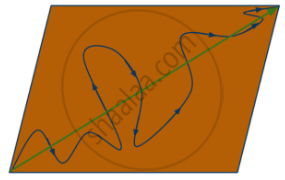Advertisements
Advertisements
Question
What is the difference between distance travelled by a body and its displacement ? Explain with the
help of a diagram.
Solution
| Distance | Displacement |
| 1.Distance has only magnitude, with no specified direction. | 1.Displacement has magnitude as well as direction. |
| 2.It is a scalar quantity. | 2.It is a vector quantity. |
| 3.Two different distances can be added directly. | 3.We have to follow the vector addition method to add displacements. |
One difference in diagrammatic form is as follows:

Here the curved line is the distance traveled and the straight line is the magnitude of the displacement.
APPEARS IN
RELATED QUESTIONS
State whether distance is a scalar or a vector quantity.
A body travels a distance of 3 km towards East, then 4 km towards North and finally 9 km towards East.
What is the total distance travelled ?
Can displacement be zero even if the distance is not zero? Give one example to explain your answer.
A body at rest is made to fall from the top of a tower. Its displacement at different instants is given in the following table:
| Time (in s) | 0.1 | 0.2 | 0.3 | 0.4 | 0.5 | 0.6 |
| Displacement (in m) | 0.05 | 0.20 | 0.45 | 0.80 | 1.25 | 1.80 |
Draw a displacement-time graph and state whether the motion is uniform or non-uniform?
A ball moves on a smooth floor in a straight line with uniform velocity 10 m s-1 for 6 s. At t = 6 s, the ball hits a wall and comes back along the same line to the starting point with the same speed. Draw the velocity-time graph and use it to find the total distance travelled by the ball and its displacement.
A car starting from rest accelerates uniformly to acquire a speed 20 km h-1 in 30 min. The distance travelled by a car in this time interval will be _____________
Draw displacement – time graph for the following situation:
When a body is moving with uniform velocity.
The table below shows the distance travelled by two vehicles A and B during each second:
| Time (s) | 0 | 1 | 2 | 3 | 4 | 5 | 6 | 7 |
| Distance travelled by A (m) | 0 | 20 | 80 | 180 | 240 | 300 | 360 | 420 |
| Distance travelled by B (m) | 0 | 10 | 40 | 90 | 160 | 250 | 360 | 490 |
Which vehicle is moving with uniform velocity?
Distance travelled by a freely falling body is proportional to ______.
Displacement magnitude can be greater than the distance traveled by the object.
